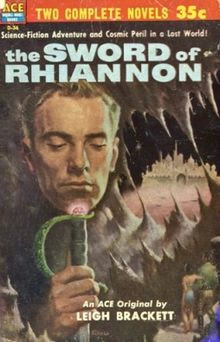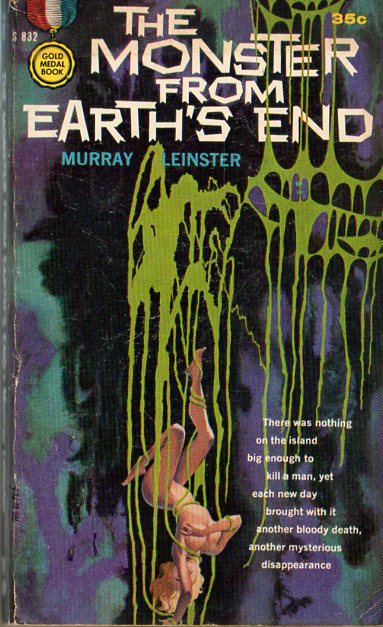The Sword of Rhiannon by Leigh Brackett
Lightning-cracked time portals. Secret tombs. Slave ship mutiny. Snake men. Buried alive. Parlays with kings. These are just some of the adventurous elements of Leigh Brackett’s The Sword of Rhiannon. (Though initially published as Sea Kings of Mars, it quickly changed names, and in reprintings since has consistently been known as The Sword of Rhiannon.) Written in 1953, it was one of the last threads of the pulp era yet benefits from increased expectations regarding prose and characterization. It never, however, fails as an adventure.
Matt Carse, Earthman and grave looter on Mars, meets with the opportunity of lifetime one evening walking the streets of Jekkara. Shown the mystical sword of the mighty and long dead sorceror Rhiannon, its gleaming jewel only set his mind moving in other directions: where there is such a beautiful sword, there must also be treasure of greater magnitude. Taken to the tomb, its there his greed gets the better of him. Examining a particularly strange artifact, the rug is pulled from under his feet and, like Alice, through the rabbit hole Carse goes. With only Rhiannon’s sword in hand, he arrives at a Mars millions of years in the past and into the middle of one of the biggest plots the planet has ever known. Carse’s problem is, his actions are what unleash the plot and send the world of the Sea Kings into turmoil.
There is no doubt that The Sword of Rhiannon has its roots in the stories of Edgar Rice Burroughs, Robert E. Howard, and others. But with the value of hindsight and the increased expectations of readers given the overall evolution and maturing of the field, Brackett elides dross and focuses her storylines, dumbs down the uber-hero qualities of her protagonists to somewhere just above everyday Joe status, and looks forward politically in terms of assumptions regarding gender, class, and other troublesome areas that underlie the stories of the early pulp writers. At the same time, she has a firm grasp on what makes pulp fiction enjoyable; visuals, action, adventure, and sense of wonder are present in spades. Entering Rhiannon’s tomb, discovering what’s hiding in Emer’s closet, the crystal technology of the climactic scene—these are moments of vivid storytelling the genre is perhaps most renowned for.
In the end, The Sword of Rhiannon is classic planetary romance. Ideologically empty, it earns its keep by telling a brisk, exciting adventure and presenting colorful and engaging imagery. Possessing the classic comedic side-kick, a mysterious female character, winged men, and technology from so far in the past none know how to operate it, all the ingredients are in place for fun. As minor as it may be in comparison to the focus on delivering an enjoyable story, Brackett steps on few toes politically as she spins her adventure. Women with agency, class equality, and other ideas are hidden away amongst sword fights, minds trapped within minds, and, of course, the fate of Mars. (Speculiction)
Matt Carse, Earthman and grave looter on Mars, meets with the opportunity of lifetime one evening walking the streets of Jekkara. Shown the mystical sword of the mighty and long dead sorceror Rhiannon, its gleaming jewel only set his mind moving in other directions: where there is such a beautiful sword, there must also be treasure of greater magnitude. Taken to the tomb, its there his greed gets the better of him. Examining a particularly strange artifact, the rug is pulled from under his feet and, like Alice, through the rabbit hole Carse goes. With only Rhiannon’s sword in hand, he arrives at a Mars millions of years in the past and into the middle of one of the biggest plots the planet has ever known. Carse’s problem is, his actions are what unleash the plot and send the world of the Sea Kings into turmoil.
There is no doubt that The Sword of Rhiannon has its roots in the stories of Edgar Rice Burroughs, Robert E. Howard, and others. But with the value of hindsight and the increased expectations of readers given the overall evolution and maturing of the field, Brackett elides dross and focuses her storylines, dumbs down the uber-hero qualities of her protagonists to somewhere just above everyday Joe status, and looks forward politically in terms of assumptions regarding gender, class, and other troublesome areas that underlie the stories of the early pulp writers. At the same time, she has a firm grasp on what makes pulp fiction enjoyable; visuals, action, adventure, and sense of wonder are present in spades. Entering Rhiannon’s tomb, discovering what’s hiding in Emer’s closet, the crystal technology of the climactic scene—these are moments of vivid storytelling the genre is perhaps most renowned for.
In the end, The Sword of Rhiannon is classic planetary romance. Ideologically empty, it earns its keep by telling a brisk, exciting adventure and presenting colorful and engaging imagery. Possessing the classic comedic side-kick, a mysterious female character, winged men, and technology from so far in the past none know how to operate it, all the ingredients are in place for fun. As minor as it may be in comparison to the focus on delivering an enjoyable story, Brackett steps on few toes politically as she spins her adventure. Women with agency, class equality, and other ideas are hidden away amongst sword fights, minds trapped within minds, and, of course, the fate of Mars. (Speculiction)



Comments
Post a Comment